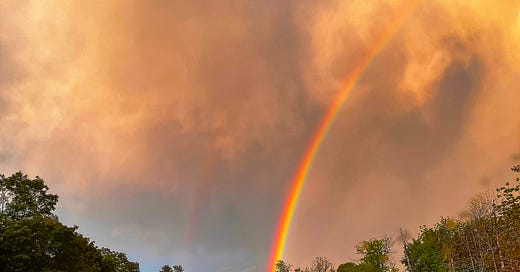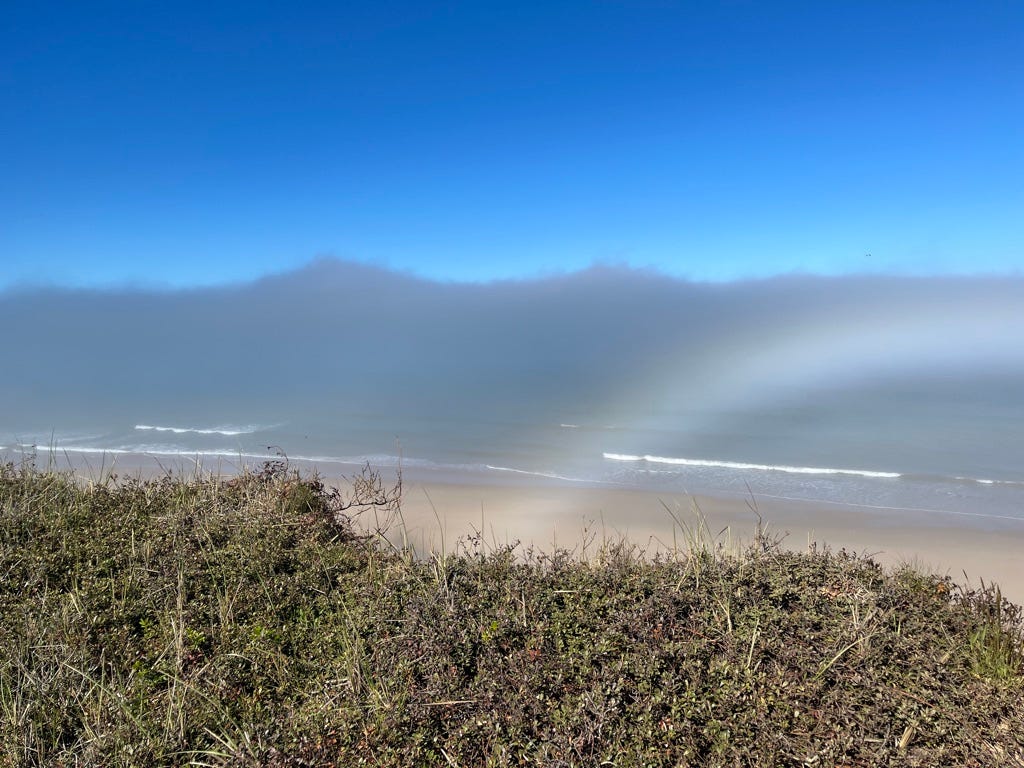A week and a half ago, driving home from points south after clouds and rain all day, the sun came back out and an intensely saturated rainbow rose up from the horizon — a double rainbow, actually. I pulled over to soak it in, knowing rainbows disappear as suddenly as they materialise. The particular quality to that light — golden, shimmering, rich — reminded me of the light in certain Turner paintings. Yet in spite of the immense beauty, I felt a sense of mourning, an indefinable yearning — for what? I still don't know.
Rainbows have stirred the imaginations of people in all cultures and throughout all of human history. In Greek mythology, the goddess Iris is the personification of the rainbow, bearing messages between the gods on Mount Olympus and the mortal world. In ancient texts, Iris is variously described as "the wind-footed, the swift, the storm-footed, Iris of the golden wings…" to name just a few of the expressive epithets used to describe her. In addition to her role as messenger of the deities, she was also called upon to take water from the River Styx to Mount Olympus for the gods to swear by in ceremonial proceedings. After drinking of this water prior to taking a solemn oath, any god or goddess who lied would be rendered unconscious for one year.
Iris is shown here in a painting ca 1793 by the English artist Guy Head, entitled “Iris Carrying the Water of the River Styx to Olympus for the Gods to Swear By.” A very faint rainbow seems to stream out behind her from her golden tresses.
The messages Iris delivered to mortals from on high often had to do with matters of war and retribution. In Homer's Iliad, Iris delivers a message to the Trojans from Zeus during the Trojan War:
Now to the Trojans came as messenger wind-footed Iris, in her speed, with the dark message from Zeus of the aegis. These were holding assembly in front of the doors of Priam gathered together in one place, the elders and the young men. Standing close at hand swift-running Iris spoke to them, and likened her voice to that of the son of Priam...In this man’s likeness Iris the swift-running spoke to them:
‘Old sir, dear to you forever are words beyond number as once, when there was peace; but now stintless war has arisen. In my time I have gone into many battles among men, yet never have I seen a host like this, not one so numerous. These look terribly like leaves, or the sands of the sea-shore, as they advance across the plain to fight by the city….’
A more modern and popular myth about the rainbow originated in Ireland, where it is told that leprechauns hid their gold in pots at both ends of the rainbow. If you can just find the end of the rainbow, then … The arc visible to us creates an illusion that if we go 'just a little further' we'll come to where it ends — but it never ends. Rainbows don't have ‘ends’ because they are actually circular. More of the circle can be seen from very high mountaintops, but to witness the full circle you'd have to be a lucky pilot in an aircraft.
Whether carrying solemn messages from heaven or representing a symbol of hope and unity; inspiring works of art and literature or forming the basis for folklore, prayer, and ceremony; or appearing as adornment on stickers, T-shirts, and other merchandise, the rainbow continues to stir something deep within the human psyche. The sight of a rainbow after a storm seems to take us out of the world for a moment, providing a vision of something beyond earthly concerns.
A related phenomenon of atmospheric optics is the "fog bow" — known by various other names, such as ghost rainbow, white rainbow, cloudbow, mistbow, or sea dog. The first time I saw one, I didn't know what I was looking at, but I whipped out my phone and took a picture — and also managed to capture a video that shows the complete arc (see below).
The multicolored arc of a rainbow is made by light striking water droplets. The most familiar kind of rainbow is seen when sunlight strikes raindrops in front of the viewer at an exact angle of 42 degrees. Rainbows are also seen around fog, sea spray, waterfalls, or even the spray from a garden hose. A fog bow is formed in a similar way, as explained on this National Geographic site, along with a more detailed explanation of how rainbows are formed:
"... a fog bow is formed in much the same way as a primary rainbow. Light in a fogbow is refracted and reflected by fog (water droplets suspended in air). A fogbow seen in the clouds is called a cloudbow. Because the water droplets in fog are much smaller than raindrops, fogbows have much fainter colors than rainbows. In fact, some fogbows have few detectable colors at all and appear mostly white, with a reddish tinge on their outer edge and a bluish tinge on their inner edge. "
Here's a charming blog post on fog bows by Ryan Knapp, then Staff meteorologist at Mount Washington Observatory. And below is my own video of the fogbow pictured above.
But back to the rainbow of last week ... I'm still puzzling over how affected I was on that particular day, as I stood incredulous in the golden light of the after-storm and the glorious arc rising from the mist over the mountains and hills where I live. Why did it feel so indescribably poignant? In the presence of such haunting beauty, what message does the rainbow offer, and how might we receive it here on earth? It leads me to wonder whether it has something to do with the historical moment we find ourselves in right now. As in a previous post referencing the North Star, rainbows represent to me a steadfast reference point. They obey their own rules, impervious to the vagaries of humankind. The rainbow's offering of light, mystery, and color cannot be commandeered or taken from us.
The poem below is by Percy MacKaye of the Cornish Arts Colony, an artist's colony founded in New Hampshire by the sculptor Augustus Saint-Gaudens which included notable painters, sculptors, writers, and architects. The poem was written as part of an original masque in 1905, staged to celebrate 20 years of the colony and to honor Saint-Gaudens, its founder. He had been suffering from cancer for 5 years and would die two years later at age 59.
In 2005, I was commissioned to write a new script for a production commemorating the 100th anniversary of the original pageant that honored Augustus Saint-Gaudens. Both pageants were performed at the same location, at the “Temple” in the field below his house and studio.
Both the original production and the new one open with the appearance of the goddess Iris, speaking MacKaye’s evocative words that invoke the magical world of gods and goddesses. (You can see a brief description of both events in the PDF below, titled “Commemorating America’s First Pageant.”)
PROLOGUE TO A MASQUE AT ASPET
AS GIVEN BEFORE AUGUSTUS AND AUGUSTA SAINT-GAUDENS
JUNE XX MCMV
Fresh from the courts of dewy-color'd eve
Jove summons me before you.....Who I am
And why he bids me here I must declare
My home is half-light: you have watched me oft
Through closing lids at noon-tide or at dusk—
Moving between the daylight and your dreams—
A shape illusory whether I pause
Midway my quivering arc that spans the roar
And tumbling prisms of sheer Niagara
Or by the ferny banks of Blow-Me-Down
Trellis my hair with braided fleur-de-lys
Still I am Iris and my mission is
To shatter the white beam of garish day
Into a thousand mellower tints of twilight
Spinning across the sceptic eyes of reason
Fine rainbow films of fancy ...







Any way we can get an urnful of water from the Styx to our president and his minions? Imagine the bliss of a year of silence.
Ahhh, for pails and pails of Isis water to be consumed by this Administration! Rainbows all around.